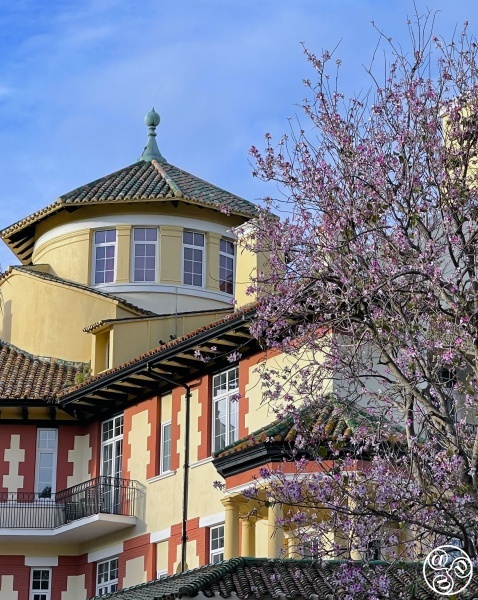
The remains of Paco de Lucía rest in the old municipal cemetery of Algeciras. |
|
Paco de Lucia Route, Algeciras
By Fiona Flores Watson
Francisco Gustavo Sánchez Gómez (Algeciras; 21 December 1947 - Playa del Carmen; 25 February 2014), affectionately known as Paco de Lucía. One of the most famous and influential flamenco guitarists ever, if not the most famous, was Paco de Lucia, who hailed from Algeciras.
You can follow the town's route of places around Algeciras which were important to the artist, starting at his birthplace, and moving south along the shoreline of the city.
The places are either in the city centre which must be explored on foot, or located outside which can be explored by car. If time is short we recommend: 6 - the monument, 8 - the cemetry and 5 - Hotel Reina Cristina and gardens.
1) Calle San Francisco 8 - where Paco de Lucia was born on 21 December 1947 as Francisco Sanchez Gomez. La Bajadillas was a gypsy neighbourhood. The youngest of five, his father was a guitar player and composer, and two of his brothers are also musicians. Paco started playing at a young age, encouraged by his father, practising 12 hours a day. Later they moved to Calle Barcelona, and then to Madrid.
2) Calle Municion (now called Calle Comandante Gomez Ortega) - the well-to-do of the city would gather in the many bars which then existed in this street for flamenco jondo get-togethers. Paco's father Antonio played at the parties, accompanying a singer, and sometimes took his sons along to the bars to listen to Niño Ricardo. In his 1998 album Luzia - dedicated to his beloved mother, in whose honour he took his stage name; the unusual spelling is for her Portuguese roots - his song Municion recalls those days.
3) Plaza Alta - the main square in Algeciras which looks out over the bay, is also the name of a song on Almoraima CD. The plaza holds happy memories of fun childhood experiences for Paco - balloons and games. Hustle and bustle of the morning, stillness of the afternoon.
4) Mercado de Abastos - the city's covered market, with its magnificent dome, where his mother, Luzia, did her shopping every day. His father had a fabric stall in the market.

Reina Cristina in Algercias
cerca 1995.
5) El Chorruelo - this was the beach of the Hotel Reina Cristina, built by the British in the 19th century for those travelling by boat across the bay to and from Gibraltar, and by railway to Ronda. Paco's brother worked at the hotel, then one of Spain's most expensive. The beach, which had huts and a casino-spas, disappeared when the port was built, but the hotel is still as elegant, with its beautiful palm-tree-filled gardens. You can drive into the hotel grounds, park the car, explore the gardens, pop into the hotel for a drink and view the historic photos on the walls. Hotel Reina Cristina, has a storied history dating back to its opening in 1901. Initially built to accommodate British travelers, it quickly became a luxurious retreat for European aristocracy and notable figures, including Winston Churchill and Alfonso XIII of Spain. Its proximity to the port made it a strategic location during both World Wars, hosting various dignitaries and military personnel. The hotel's architecture, blending Moorish and Andalusian styles, reflects the region's rich cultural heritage. Despite modern renovations, Reina Cristina retains its historic charm, continuing to be a significant landmark in Algeciras. More about Algeciras beaches

Paco de Lucía statue, at pre 2017 location on roundabout.
6) Monument - this bronze by the sculptor Ignacio Falgueras Cano is a monument to the artist, inaugurated in 1994, was moved several times, until current site in 2017, near entrance to port. As he said once to Jesus Quintero in an interview "El hombre que nace junto al mar es más soñador (...) Yo necesito esa expansión que te da el mar" (Anyone who is born by the sea is more of a dreamer. I need that sense of space which the sea gives me.) He also said that he loved the sea: swimming, fishing, going out in his boat - were that give him tranquility.
7) Punta de Faro - is the name of a bulerías-style flamenco composition from his 1972 album 'El duende flamenco'. The lighthouse refered to is at Punto Canero to the north of Algeciras city and Getares district. It looks over the Strait of Gibraltar, where the Mediterranean and Atlantic meet. More >
8) Old Cemetery - this is where his grave is located, complete with bust and guitar sculpture. Paco died in Playa del Carmen, Tulum, in Mexico, on 25 February 2014, where he was playing on the beach with his family.
9) Casa Bernardo - a chiringuito just to the north of Algeciras town, near Playa del Rinconcillo where Paco's beach house was located, and is also the name of song on Cositas Buenas.
10) Rio de la Miel - this is a river whose source is in the Sierra de la Luna, and which enters Algeciras in a barrio called Rio Ancho, as well as a song from the album Luzia.
Did you know that
At the age of 11, Paco made his first public appearance - on Radio Algeciras.
Paco was the first-ever flamenco guitarist to perform at Madrid's Teatro Royal.
He recorded songs for original movie soundtracks of films by Woody Allen (Vicky Cristina Barcelona) and Wes Anderson (The Life Aquatic With Steve Zissou).
Video
Paco de Lucia playing 'Entre dos Aguas' in 1976 on spanish TV1

